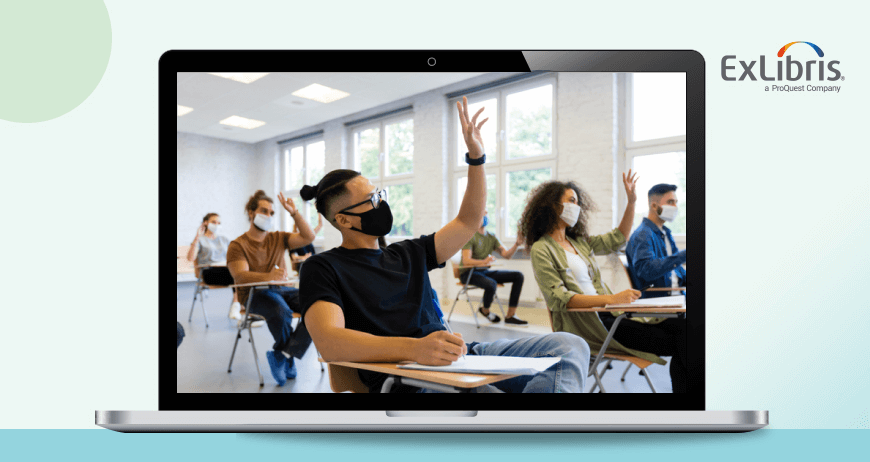Hadas Tayeb, Product Marketing Manager, campusM, Ex Libris
Do students want to return to campus? The answer is yes, no, and maybe.
A recent Student Voice survey conducted by Inside Higher Ed and College Pulse reveals contradicting attitudes towards synchronous learning from students that are already back on campus in a full- or part-time capacity. One telling finding from the survey is that while nearly a third of the 2,000 respondents never want to participate in a Zoom class again, 9% of those surveyed never want to go back to in-person learning.
The spectrum of student reactions to the return to campus suggests there is no one right way to welcome students back. As some institutions look to return to full in-person classes in Fall 2021, other are exploring hybrid learning options. In both cases, some information and tools will be useful for all returning students, while some students may require additional support and motivation to get back into the academic cadence and campus activities.
For colleges that have yet to return to in-person learning, this is the time to start reaching out to students to understand how they feel about coming back and what their expectations are from the institution upon reentry. A campus app can help colleges identify how each student feels about returning to synchronous learning, and allow colleges to push targeted resources and tools to students to better prepare them for their campus homecoming.
Get Meaningful Qualitative Data, Fast
There is no doubt that you want to listen to your students but being able to hear them is another matter. Using a campus app’s Quick Poll feature to gather student responses about the return to campus can be useful at the macro and micro level. As an example, let’s imagine the following Quick Poll with three possible answers:
How do you feel about the college’s Covid-19 safety policies for Fall 2021?
- I feel that the college’s Covid-19 safety policies are robust
- I do not feel that the college’s Covid-19 safety policies are adequate
- I don’t know enough about the college’s Covid-19 safety policies
Using these responses, the institution can make smarter decisions about how to communicate their Covid-19 safety strategy. For instance, if the majority of respondents answered that they don’t know enough about the safety policies, the college could launch a more intense email and social media campaign to make students more aware of what to expect on campus from a safety perspective.
Campus app Quick Poll responses can be just as useful on an individual level, with each response triggering a follow-up action. Students that answered that they do not feel confident in the college’s safety plan could be sent to a landing page with more information about the safety policies and an option to send a message to Student Affairs about their concerns. In this way, colleges can tailor their app messaging to the students to assuage fears and align them with the institution’s safety thinking.
Use your Data for Wellness Checkups
As remote learning became a reality, colleges and universities got creative with their learning analytics to facilitate wellness reports and identify at-risk students from afar. Student attendance check-ins, logins to Learning Management Systems or mobile SIS, library checkouts and even tile clicks all contributed to students’ wellness reports.
As the Student Voice survey demonstrates, staying on top of student wellness will be just as critical in the return to campus as it was during remote learning. Utilizing the student data captured from a campus mobile solution gives colleges a richer picture of each student’s engagement or disengagement, and can help wellness teams catch small problems before they become big ones.
Improve Classroom Attendance with Push Notifications
For many students, the return to in-class learning does not mean they remember where these classes are, or how to get there. By using built-in attendance features and student timetable data, institutions can leverage their college mobile app to send automatic push notifications reminding students about upcoming classes. Including links in these notifications to useful information for each class, such as the class room number and a map of how to get to the correct building, will make it easier for students to turn up in class on time and less stressed.
Put new Covid-19 Policies Front and Center
Though students will be returning to familiar lecture halls, dormitories and quads, the campus experience will be different. Though many colleges are only planning to start on-site learning in Fall 2021, institutions can already start to prepare students and prospects for the upcoming changes like contact tracing and mask-wearing policies through their campus app.
Institutions can begin to group links to online resources about the return to campus within a designated college campus app tile, giving students an easy access point to all the available information on reorientation and safety precautions. As the start of term gets closer, colleges can use banner tiles to attract their students’ attention and provide direct links to the resources that clarify new behavioral expectations on campus.
For colleges that will be mandating vaccines, setting up a vaccination tile will give students a quick and easy way to learn more about vaccinations on campus, including
- Vaccination center locations and hours
- Phone numbers for the campus medical center
Once a student is vaccinated, that status can be added to her digital ID card, making it simple for her to validate her vaccination status on campus should she be asked to do so.
Make Attestation Simple
Many colleges are adopting daily attestations to limit outbreaks of Covid-19 and to identify individuals who may need to self-isolate. Letting students use their campus app to attest when they first enter campus consolidates attestation data, making it simple to export and review.
Designating a tile for attestation can also simplify the attestation process for students. Washington State University, a campusM customer, was requiring students to attest every time they entered a different building on campus. After students requested a 1-per-day attestation solution, the university’s information technology services and campusM developers created a new tile for instant, all-day attestation.
Do students want to return to campus?
To a certain extent, that depends on how the college is talking to them about its return strategy. Colleges that leverage campus mobile apps to learn from, inform, and send personalized content to their students about what to expect from in-person classes can reach higher levels of student engagement in the buildup to reentry.
campusM is a powerful campus app that helps universities improve student engagement on a daily basis. Learn more about how campusM empowers institutions to deliver exceptional mobile experiences and services for students, including access to the library mobile app. This intuitive app streamlines library resources and services, making it easier for students to find the information and support they need, right at their fingertips.










